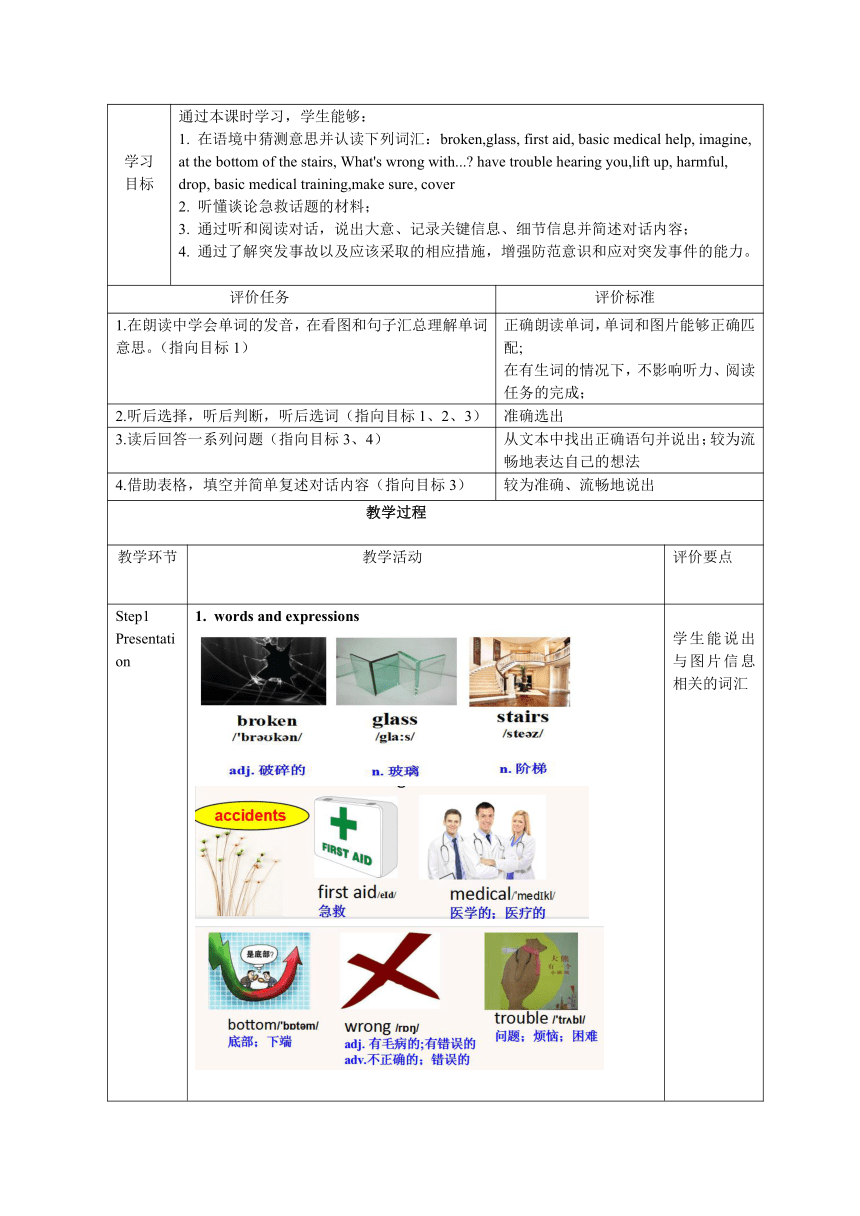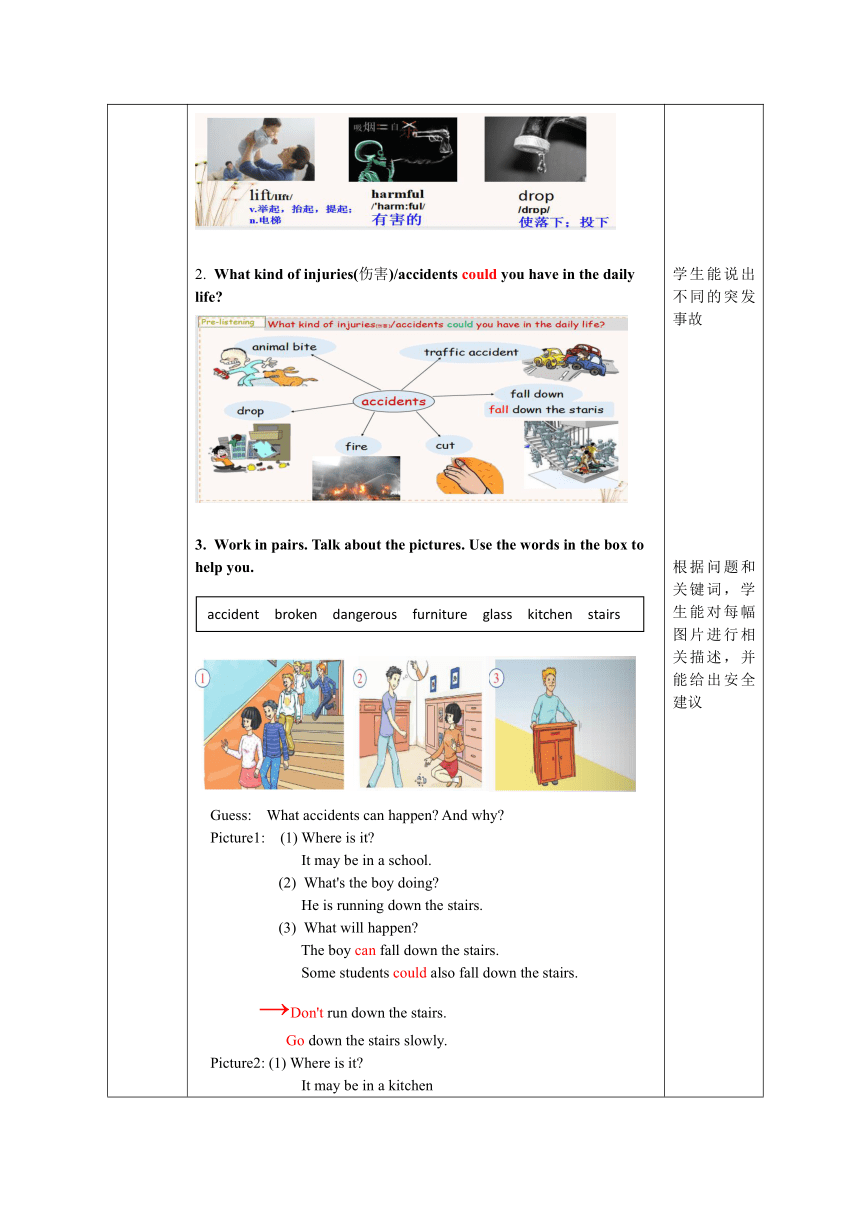外研版八年级英语上册 英语Module 12 Help Unit 1 课时备课卡(表格式教案)
文档属性
| 名称 | 外研版八年级英语上册 英语Module 12 Help Unit 1 课时备课卡(表格式教案) |  | |
| 格式 | docx | ||
| 文件大小 | 1.2MB | ||
| 资源类型 | 教案 | ||
| 版本资源 | 外研版 | ||
| 科目 | 英语 | ||
| 更新时间 | 2022-08-17 08:22:11 | ||
图片预览



文档简介
基于课程标准的“教学评一体化”设计
课时备课卡
课题 八上 Module 12 Help Unit1 What should we do before help arrives
日期 课时 1 课型 听说 授课教师
审核人
目标 确立 依据 课标 分析 课标摘录 义务教育《英语课程标准》语言技能四级标准: 听1. 能听懂接近自然语速、熟悉话题的简单语段,识别主题,获取主要信息; 读3. 能从简单的文章中找出有关信息,理解大意; 4. 能根据上下文猜测生词的意思。
课标分解 1.能通过听对话,选择或说出对话的主题、听懂谈论急救话题的材料; 2.能通过阅读对话,找出对话中的具体人物、时间、地点、原因等信息;能选出或说出对话的主要内容; 3. 能在语境中猜出生词的意思,不妨碍听和阅读的理解。
教材 分析 本模块谈论安全和急救方面的话题,涉及谈论突发事故以及应该采取的相应措施。突发事件是人们在日常生活中经常需要面对的问题。本模块第一单元的对话是关于如何做急救的。Unit1的主要内容为Ms James 在主题为急救的课堂上假设了一个意外场景:一个男生痛苦万分地躺在楼梯底部,不能作声也不能动弹,然后引导Betty,Lingling和Tony三位学生讨论急救方法。对话中营造的场景很自然地导入了must, can, could表示推测的用法以及祈使句的肯定式和否定式。了解一些实用的急救方法不仅可以帮助学生在关键时刻自救,而且能够提高其救助他人的意识和能力。本单元的学习分为两个课时完成,第一课时侧重听说练习,第二课时进行词汇、句型的操练和语法总结。
单元六要素整合设计 活动一 活动二活动三活动四主题Safety and first aid 目标:First aid advice for the accidents 语篇语篇1 文化了解应对突发事故和灾难的方法和措施,增强防范意识和能力 语言使用情态动词must,can,could 表示推测;使用祈使句表示建议和指导 行为听/读/说听/读/说读/说/写读/说/写 方法听力/阅读策略运用;辨析情态动词表推测,辨析祈使句
学情 分析 本文的话题引入的场景和学生的生活关联度高,比较容易激起学生的兴趣,但部分学生比较缺乏急救知识。如何系统地描述意外事故及急救方法,还需要老师的引导。 从语言上看,学生对理解文章内容没有障碍,对于祈使句和情态动词could、might、would表推测也有一定认识,但是对描述意外及急救方法缺乏系统的框架;在听和阅读的过程中,克服生词障碍、猜测词义的能力还有待提高。
学习 目标 通过本课时学习,学生能够: 1. 在语境中猜测意思并认读下列词汇:broken,glass, first aid, basic medical help, imagine, at the bottom of the stairs, What's wrong with... have trouble hearing you,lift up, harmful, drop, basic medical training,make sure, cover 2. 听懂谈论急救话题的材料; 3. 通过听和阅读对话,说出大意、记录关键信息、细节信息并简述对话内容; 4. 通过了解突发事故以及应该采取的相应措施,增强防范意识和应对突发事件的能力。
评价任务 评价标准
1.在朗读中学会单词的发音,在看图和句子汇总理解单词意思。(指向目标1) 正确朗读单词,单词和图片能够正确匹配; 在有生词的情况下,不影响听力、阅读任务的完成;
2.听后选择,听后判断,听后选词(指向目标1、2、3) 准确选出
3.读后回答一系列问题(指向目标3、4) 从文本中找出正确语句并说出;较为流畅地表达自己的想法
4.借助表格,填空并简单复述对话内容(指向目标3) 较为准确、流畅地说出
教学过程
教学环节 教学活动 评价要点
Step1 Presentation Step 2 Listening (SB A.2) Step 3 Dialogue (SB A.3) Step 4 Homework words and expressions What kind of injuries(伤害)/accidents could you have in the daily life Work in pairs. Talk about the pictures. Use the words in the box to help you. Guess: What accidents can happen And why Picture1: (1) Where is it It may be in a school. What's the boy doing He is running down the stairs. What will happen The boy can fall down the stairs. Some students could also fall down the stairs. →Don't run down the stairs. Go down the stairs slowly. Picture2: (1) Where is it It may be in a kitchen What's Lingling doing She is picking up the broken glass. What will happen to Lingling She could hurt her fingers. →Don't touch anything sharp. Picture3: (1) What's the boy doing He is moving the furniture. He is lifting the furniture up. Is it easy for him No, it isn’t. What will happen to the boy The boy could drop it and hurt his feet. →Don't lift up too heavy things! Listen and answer: What is the material about How do accidents often happen A traffic accident A school accident Listen and fill in the blanks. Accidents often ________ before you notice them. You could _____ when you go down the ______at school. It’s quite dangerous in the _______ at home because _____________ or _______can cut you. And moving heavy _______ is dangerous too. You could ______ it and ____ your foot. 3.Work in pairs and describe the pictures in more sentences. Talking after listening. 4. Further thinking Accidents are everywhere, what can we do with it 1. Listen and answer. What’s the conversation about A terrible school accident A class about an accident. A class about how to give first aid. 2.Listen and check. (1) Ask the boy what is wrong. ( ) (2) Get help. ( ) (3) Shout so the boy can hear you. ( ) (4) Move the boy to a more comfortable place. ( ) (5) Make sure the boy is warm. ( ) Listen and complete the table. warm what’s wrong lift 120 cover comfortable trouble drop harmful Shout
4. Read the dialogue Read and answer the following questions. What is this morning’s class about Do you think it necessary to learn something about first aid or do some basic medical training Why In this imaginary accident, what’s wrong with the boy What will you do when you see someone lying at the bottom of the stairs without moving or making a sound Can you give some other first aid advice in such an accident 5. Go over the dialogue,complete the table and then retell the main content with the partner. This morning’s class is about_____, or giving someone__________. Let’s_________ an accident, a boy is lying _________________. He isn’t__________. He is __________. What can we do to help him Read aloud the new words and phrases. Read aloud the dialogue. Choose one of them to finish: Try to retell the dialogue next class. Try to retell the dialogue next class and show more first aid advice. Search for more information about accidents and first aid from books or on the internet and share it with the class next time. 学生能说出与图片信息相关的词汇 学生能说出不同的突发事故 根据问题和关键词,学生能对每幅图片进行相关描述,并能给出安全建议 学生能选出对话主题 学生能听辨关键词并写出 学生能流利地表达出 听力素材的内容并描绘图片更多内容。 学生能根据图片并结合自己的生活实际说出一些应急措施 学生能选出正确的大意 学生能获取关键信息并判断对错 学生能听到关键词并选词填表 学生能根据文本信息并结合实际思考回答下列问题。 学生能根据提示,简要说出对话主要内容。85%以上的学生能够说出 结合表格复述对话内容,并提供更多急救建议 熟读词汇、对话
课时备课卡
课题 八上 Module 12 Help Unit1 What should we do before help arrives
日期 课时 1 课型 听说 授课教师
审核人
目标 确立 依据 课标 分析 课标摘录 义务教育《英语课程标准》语言技能四级标准: 听1. 能听懂接近自然语速、熟悉话题的简单语段,识别主题,获取主要信息; 读3. 能从简单的文章中找出有关信息,理解大意; 4. 能根据上下文猜测生词的意思。
课标分解 1.能通过听对话,选择或说出对话的主题、听懂谈论急救话题的材料; 2.能通过阅读对话,找出对话中的具体人物、时间、地点、原因等信息;能选出或说出对话的主要内容; 3. 能在语境中猜出生词的意思,不妨碍听和阅读的理解。
教材 分析 本模块谈论安全和急救方面的话题,涉及谈论突发事故以及应该采取的相应措施。突发事件是人们在日常生活中经常需要面对的问题。本模块第一单元的对话是关于如何做急救的。Unit1的主要内容为Ms James 在主题为急救的课堂上假设了一个意外场景:一个男生痛苦万分地躺在楼梯底部,不能作声也不能动弹,然后引导Betty,Lingling和Tony三位学生讨论急救方法。对话中营造的场景很自然地导入了must, can, could表示推测的用法以及祈使句的肯定式和否定式。了解一些实用的急救方法不仅可以帮助学生在关键时刻自救,而且能够提高其救助他人的意识和能力。本单元的学习分为两个课时完成,第一课时侧重听说练习,第二课时进行词汇、句型的操练和语法总结。
单元六要素整合设计 活动一 活动二活动三活动四主题Safety and first aid 目标:First aid advice for the accidents 语篇语篇1 文化了解应对突发事故和灾难的方法和措施,增强防范意识和能力 语言使用情态动词must,can,could 表示推测;使用祈使句表示建议和指导 行为听/读/说听/读/说读/说/写读/说/写 方法听力/阅读策略运用;辨析情态动词表推测,辨析祈使句
学情 分析 本文的话题引入的场景和学生的生活关联度高,比较容易激起学生的兴趣,但部分学生比较缺乏急救知识。如何系统地描述意外事故及急救方法,还需要老师的引导。 从语言上看,学生对理解文章内容没有障碍,对于祈使句和情态动词could、might、would表推测也有一定认识,但是对描述意外及急救方法缺乏系统的框架;在听和阅读的过程中,克服生词障碍、猜测词义的能力还有待提高。
学习 目标 通过本课时学习,学生能够: 1. 在语境中猜测意思并认读下列词汇:broken,glass, first aid, basic medical help, imagine, at the bottom of the stairs, What's wrong with... have trouble hearing you,lift up, harmful, drop, basic medical training,make sure, cover 2. 听懂谈论急救话题的材料; 3. 通过听和阅读对话,说出大意、记录关键信息、细节信息并简述对话内容; 4. 通过了解突发事故以及应该采取的相应措施,增强防范意识和应对突发事件的能力。
评价任务 评价标准
1.在朗读中学会单词的发音,在看图和句子汇总理解单词意思。(指向目标1) 正确朗读单词,单词和图片能够正确匹配; 在有生词的情况下,不影响听力、阅读任务的完成;
2.听后选择,听后判断,听后选词(指向目标1、2、3) 准确选出
3.读后回答一系列问题(指向目标3、4) 从文本中找出正确语句并说出;较为流畅地表达自己的想法
4.借助表格,填空并简单复述对话内容(指向目标3) 较为准确、流畅地说出
教学过程
教学环节 教学活动 评价要点
Step1 Presentation Step 2 Listening (SB A.2) Step 3 Dialogue (SB A.3) Step 4 Homework words and expressions What kind of injuries(伤害)/accidents could you have in the daily life Work in pairs. Talk about the pictures. Use the words in the box to help you. Guess: What accidents can happen And why Picture1: (1) Where is it It may be in a school. What's the boy doing He is running down the stairs. What will happen The boy can fall down the stairs. Some students could also fall down the stairs. →Don't run down the stairs. Go down the stairs slowly. Picture2: (1) Where is it It may be in a kitchen What's Lingling doing She is picking up the broken glass. What will happen to Lingling She could hurt her fingers. →Don't touch anything sharp. Picture3: (1) What's the boy doing He is moving the furniture. He is lifting the furniture up. Is it easy for him No, it isn’t. What will happen to the boy The boy could drop it and hurt his feet. →Don't lift up too heavy things! Listen and answer: What is the material about How do accidents often happen A traffic accident A school accident Listen and fill in the blanks. Accidents often ________ before you notice them. You could _____ when you go down the ______at school. It’s quite dangerous in the _______ at home because _____________ or _______can cut you. And moving heavy _______ is dangerous too. You could ______ it and ____ your foot. 3.Work in pairs and describe the pictures in more sentences. Talking after listening. 4. Further thinking Accidents are everywhere, what can we do with it 1. Listen and answer. What’s the conversation about A terrible school accident A class about an accident. A class about how to give first aid. 2.Listen and check. (1) Ask the boy what is wrong. ( ) (2) Get help. ( ) (3) Shout so the boy can hear you. ( ) (4) Move the boy to a more comfortable place. ( ) (5) Make sure the boy is warm. ( ) Listen and complete the table. warm what’s wrong lift 120 cover comfortable trouble drop harmful Shout
4. Read the dialogue Read and answer the following questions. What is this morning’s class about Do you think it necessary to learn something about first aid or do some basic medical training Why In this imaginary accident, what’s wrong with the boy What will you do when you see someone lying at the bottom of the stairs without moving or making a sound Can you give some other first aid advice in such an accident 5. Go over the dialogue,complete the table and then retell the main content with the partner. This morning’s class is about_____, or giving someone__________. Let’s_________ an accident, a boy is lying _________________. He isn’t__________. He is __________. What can we do to help him Read aloud the new words and phrases. Read aloud the dialogue. Choose one of them to finish: Try to retell the dialogue next class. Try to retell the dialogue next class and show more first aid advice. Search for more information about accidents and first aid from books or on the internet and share it with the class next time. 学生能说出与图片信息相关的词汇 学生能说出不同的突发事故 根据问题和关键词,学生能对每幅图片进行相关描述,并能给出安全建议 学生能选出对话主题 学生能听辨关键词并写出 学生能流利地表达出 听力素材的内容并描绘图片更多内容。 学生能根据图片并结合自己的生活实际说出一些应急措施 学生能选出正确的大意 学生能获取关键信息并判断对错 学生能听到关键词并选词填表 学生能根据文本信息并结合实际思考回答下列问题。 学生能根据提示,简要说出对话主要内容。85%以上的学生能够说出 结合表格复述对话内容,并提供更多急救建议 熟读词汇、对话
同课章节目录
- Module 1 How to learn English
- Unit 1 Let's try to speak English as much as possi
- Unit 2 You should smile at her.
- Unit 3 Language in use .
- Module 2 My home town and my country
- Unit 1 It's taller than many other buildings.
- Unit 2 Cambridge is a beautiful city in the east o
- Unit 3 Language in use .
- Module 3 Sports.
- Unit 1 Nothing is more exciting than playing tenni
- Unit 2 This year we training more carefully.
- Unit 3 Language in use .
- Module 4 Planes, ships and trains .
- Unit 1 He lives the farthest from school.
- Unit 2 What is the best way to travel.
- Unit 3 Language in use .
- Module 5 Lao She Teahouse.
- Unit 1 I wanted to see the Beijing Opera.
- Unit 2 It descibes the changes in Chinese society.
- Unit 3 Language in use .
- Module 6 Animals in danger.
- Unit 1 It allows people to get closer to them .
- Unit 2 The WWF is working hard to save them all.
- Unit 3 Language in use .
- Revision module A
- Module 7 A famous story
- Unit 1 Alice was sitting with her sister by the ri
- Unit 2 She was thinking about her cat.
- Unit 3 Language in use .
- Module 8 Accidents
- Unit 1 While the car were changing to red, a car s
- Unit 2 I was trying to pick it up when it bite me
- Unit 3 Language in use .
- Module 9 Population
- Unit 1 The population of China is about 1.37 billi
- Unit 2 Arnwick was a city with 200,000 people.
- Unit 3 Language in use .
- Module 10 The weathe
- Unit 1 It might snow.
- Unit 2 The weather is fine all year round.
- Unit 3 Language in use .
- Module 11 Way of life
- Unit 1 In China ,we open a gift later.
- Unit 2 In England, you usually drink tea with milk
- Unit 3 Language in use .
- Module 12 Help
- Unit 1 What should we do before help arrives?
- Unit 2 Stay away from windows and heavy furniture.
- Unit 3 Language in use .
- Revision module B
